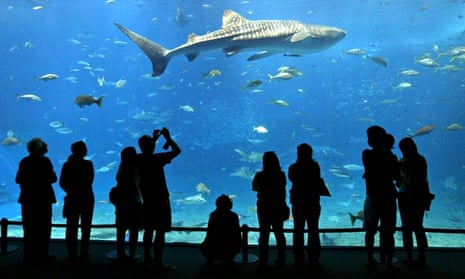It sounds like an idea for a sequel to Christopher Nolan’s hit sci-fi film Interstellar: an underwater city of 5,000 people that draws its energy from the seabed thousands of metres below. But if a Japanese construction firm gets its way, Ocean Spiral could be a reality within just a couple of decades.
Shimizu Corp, which has a reputation for dreaming up grandiose schemes, says Ocean Spiral will “capitalise on the infinite possibilities of the deep sea” to accommodate human life, as rising sea levels threaten the survival of island communities.
According to an artist’s rendering, the ambitious structure will be divided into three sections. A floating sphere with a diameter of 500 metres, located just beneath the surface of the sea, will house business and residential zones and hotels. The pod will be connected to a 15km-long spiral path that winds its way to the ocean floor 3-4km below the surface. There, scientists will explore ways to excavate energy resources from the seabed.
Officials at Shimizu said the project would take about five years to build, at an estimated cost of 3tn yen (£16bn). The firm believes the technology needed to build the structure and to sustain life below the surface of the ocean will be ready in as little as 15 years’ time.
“This is a real goal, not a pipe dream,” the Shimizu spokesman Hideo Imamura told the Guardian. “The Astro Boy cartoon character had a mobile phone long before they were actually invented – in the same way, the technology and knowhow we need for this project will become available.”
The project is drawing on experts from Tokyo University, government ministries and energy firms to turn Shimizu’s blueprint into a reality. The firm hopes to secure funding from private industry and the government. “It would be great if research institutions and governments become interested in our project,” Masaki Takeuchi, the manager of the project, told the Asahi Shimbun newspaper.
Christian Dimmer, an assistant professor in the urban studies department at Tokyo University, said “techno-utopias” such as Ocean Spiral were a response to crises, in this case climate change and rising sea levels.
“We had this in Japan in the 1980s, when the same corporations were proposing underground and ‘swimming’ cities and 1km-high towers as part of the rush to development during the height of the bubble economy. It’s good that many creative minds are picking their brains as to how to deal with climate change, rising sea levels and the creation of resilient societies – but I hope we don’t forget to think about more open and democratic urban futures in which citizens can take an active role in their creation, rather than being mere passengers in a corporation’s sealed vision of utopia,” Dimmer said.
Ultimately, Shimizu envisages an eco-friendly underwater city sustained by energy brought up from an “earth factory” on the ocean floor. The factory will use micro-organisms to turn carbon dioxide into methane, while power generators located along the ocean spiral will use differences in seawater temperatures to create additional energy – a process known as ocean thermal energy conversion. Desalinated water produced using hydraulic pressure will be pumped into the residential pod.
The idea of creating communities in the sea resonates in Japan, where land-based communities are at risk from large earthquakes and tsunamis.
It is not the first time the country’s construction industry has given serious thought to building sustainable communities in unusual places. Obayashi Corp has said it plans to build a 60,000-mile-long “space elevator” by the middle of the century.
Among Shimizu’s other ambitious projects are a lunar base, a hotel in space and floating botanical cities.
